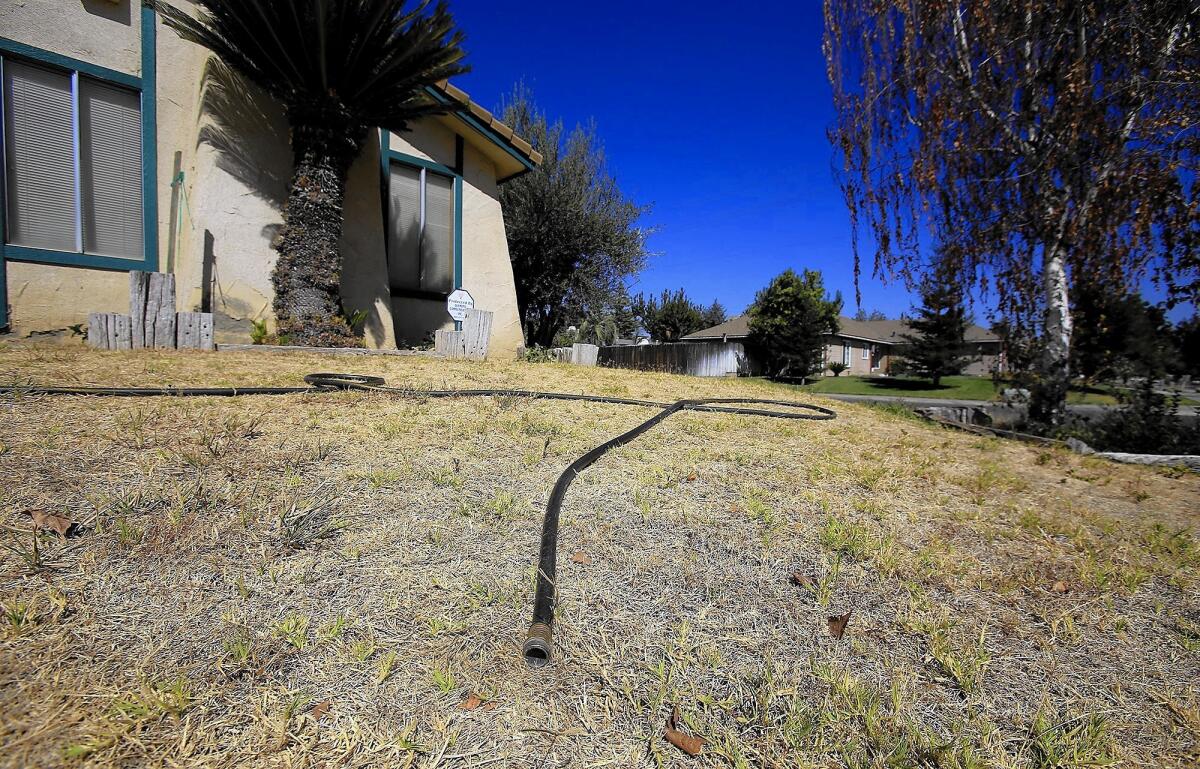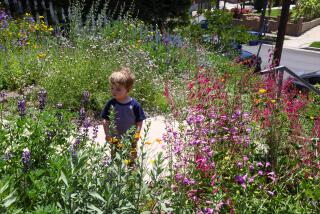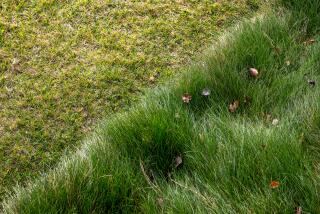The 5 biggest misconceptions about watering your lawn and garden during a drought

Four months into mandatory watering restrictions that have curbed Southern California’s residential irrigation routines, the news is both good and not so good. On the plus side, citizens are saving water — in many cases, beyond expectations. Many cities are making their mandatory cutback levels and then some.
The not-so-good news is the confusion that remains about the best possible way to keep our landscaping, and particularly the tree canopy, alive.
“People are trying to do the right thing, but they’re not sure how to do that,” says Paula Henson, a partner in the rainwater management landscape design firm Urban Water Group, which has an educational division called Terra Bella Water. Indeed, experts are pointing out that misunderstandings about when, how and what to water during the drought may be costing us, in the long run, more than we realize.
We reached out to several landscape and irrigation educators and professionals for their opinions about what they see as the most critical misconceptions about proper landscape management in a time of drought:
1. It’s OK to stop watering your lawn.
It’s tempting to simply turn off the water, particularly on the lawns. That strategy, experts note, can have a serious effect on the health of soil itself, even creating “dead soil.”
“There’s a micron-ecosystem happening in our soil,” says landscape architect and USC professor Esther Argolis. “If you don’t water, you are exterminating all life in those soils. There’s a lack of oxygenation, lack of insects and soil ecology. What are we sacrificing?”
Dead soil creates another problem, especially as we face a potentially rainy winter, Antique Silva, head of Los Angeles Department of Water and Power’s water conservation response unit, points out. “When you don’t water your lawn, the soil gets very compacted,” says Silva. Compact soil is less able to absorb rain and more likely to repel it. If you remove lawn, he says, “you absolutely should put something in that grows.”
Henson adds, “Even if you let the lawn go brown, water it every so often.” She recommends covering the lawn with mulch or dead leaves that will decompose and add organic matter to the soil.
2. Mature trees do not need water.
One of the greatest areas of confusion, our experts say, involves trees. All trees, even mature ones, need periodic watering.
In urban areas, most trees have been planted in lawns, and shutting off the water to those lawns strikes a blow at the trees as well. “The reality is most trees in Los Angeles don’t know a life without irrigation,” says Danny Car Michael, senior forestry projects manager for Tree People. “When that water all of a sudden disappears, the tree can go into shock and begin dying.”
For that reason, the L.A. Department of Water and Power, among other agencies, places no limitations on tree watering, as long as drip irrigation is used and the watering is not done between 9 a.m. and 4 p.m. “People think that if a tree is established, it doesn’t need water,” Silva notes. “Trees are stressing now. They need deeper percolation.”
For young trees, Tree People’s Car Michael recommends 10 to 15 gallons of water poured into a watering basin or berm once a week; he recommends that homeowners build them if they don’t already exist. Mature trees require periodic deep watering, he says — several hours with an in-line emitter or soaker hose that is wrapped concentrically around the tree starting from a foot from the trunk and ending at the drip line.
3. You may only water a set number of minutes a set number of times per week.
Regulations vary from city to city, water district to water district. It pays to find out exactly what the guidelines are for your area because you may be able to water more than you realize. In the city of Los Angeles, for example, the eight-minutes-three-times-a-week rule applies only to automatic sprinkler systems (even though some city officials have asked people to water only twice a week).
“Hand watering with a shut-off nozzle is allowed any day of the week,” Silva says. There is no limit on the amount of time you can hand water, only that the watering be done before 9 a.m. and after 4 p.m. Drip systems have a similar dispensation. Moreover, Silva says, low-flow, high-efficiency rotator head sprinklers can run 30 minutes a day three days per week.
4. Drought-tolerant plants do not need water.
A number of homeowners are opting to put in low-water succulents and natives. “There is always an establishment period for any plant, which means watering,” Margulies says. And if you tear out established plants and replace them with drought-tolerant ones, particularly in the hot summer and early fall months, you will need to water more than you would have if you had left your garden alone.
Fall and winter are the optimum time to transition the garden. “A lot of succulents, when they are established on native rainfall, are amazingly bulletproof,” says Tom Jensch of Waterwise Botanicals.
5. You should keep the same watering schedule all year
A major problem with automatic irrigation is that people tend to set the schedule once and never change it. All plants experience seasonal changes. Some require little or no water during the late fall and winter months, while natives may die if watered too much in the summer.
Interval watering is also important. “Breaking up the watering time is important, to let the water soak in,” Silva says. That might mean putting down half of the allotment in the morning and half at night.
MORE:
Photos: 11 Inspiring water-wise landscapes
You’ve been watering your trees all wrong: A drought expert explains how to get it right
Hey, California, you can still have a lawn! Here are five water-wise alternatives






